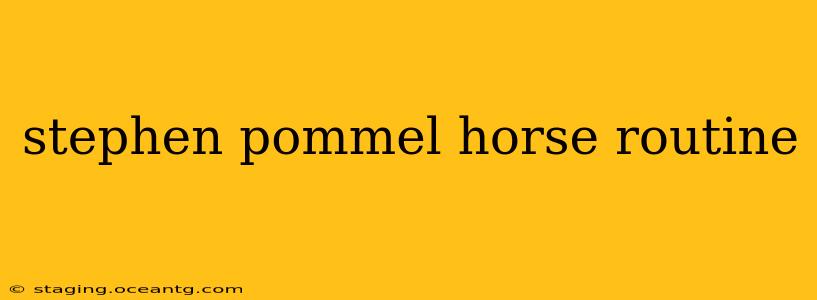Stephen, while not a universally recognized name like some of the Olympic gymnasts, represents the dedication and skill involved in mastering the pommel horse. This article will delve into the intricacies of a typical Stephen-style pommel horse routine, exploring the key elements, techniques, and the dedication required to execute them flawlessly. While we don't have access to a specific named gymnast's private routines, we'll examine the common elements and advanced techniques found in high-level pommel horse performances.
What are the key elements of a pommel horse routine?
A high-level pommel horse routine is a stunning display of strength, balance, and precision. It typically consists of a series of interconnected movements, transitioning seamlessly from one element to the next. Key elements include:
- Circles: These are fundamental movements, performed both forward and backward. Variations in size and speed add complexity and difficulty. Maintaining a stable and controlled circle is crucial.
- Handstands: Short handstands, often incorporated between other elements, demonstrate strength and balance.
- Transitions: The smooth transitions between circles and handstands are what truly elevate a routine. These require exceptional coordination and timing.
- Turns: Turns, both on the hands and in a more dynamic style, add a dramatic flair and demonstrate advanced control.
- Mounts and Dismounts: The initial mount and the final dismount are important components, requiring both elegance and technical skill. A clean dismount is essential for a high score.
What are the different types of circles performed on the pommel horse?
The circles on the pommel horse can be categorized into a few key types:
- Forward Circles: These are circles performed in a forward direction, moving along the horse's length.
- Backward Circles: These are the reverse of forward circles, performed moving backward along the horse's length.
- Large Circles: These circles have a larger diameter, requiring more strength and control.
- Small Circles: These circles have a smaller diameter, demanding precision and balance.
- Combined Circles: These involve combining forward and backward circles seamlessly, often with variations in speed and size.
What are some advanced techniques used in pommel horse routines?
Advanced pommel horse routines often incorporate elements beyond the basics:
- One-Arm Circles: These incredibly challenging movements demonstrate exceptional strength and control.
- Inverted Handstands: Showcasing incredible balance and strength.
- Complex Transitions: These may involve multiple changes in direction and position within a single movement.
- Dynamic Elements: These incorporate momentum and speed to create visually exciting transitions and sequences.
How much training is needed to master the pommel horse?
Mastering the pommel horse requires years of dedicated training. It's a highly demanding apparatus, requiring strength, flexibility, balance, and exceptional hand and core strength. Athletes often begin with basic strength training and conditioning before progressing to more advanced skills. Consistent practice and coaching are essential for improvement and injury prevention.
What are common mistakes to avoid in pommel horse routines?
Several common mistakes can hinder performance and increase the risk of injury:
- Poor posture: Maintaining proper body alignment is critical for both safety and scoring.
- Inconsistent circles: Irregular or uncontrolled circles show a lack of mastery.
- Unsteady transitions: Jerky or uncontrolled transitions negatively impact the flow and scoring of the routine.
- Incorrect grips: A strong and secure grip is crucial. Incorrect grip can lead to falls.
This detailed examination of a typical Stephen-esque pommel horse routine, though we don't have access to a specific individual's routines, showcases the complexity and athleticism involved in this challenging event. The dedication and skill required to master this apparatus are undeniable. Future articles might explore specific training methods or delve into the judging criteria for pommel horse routines.
